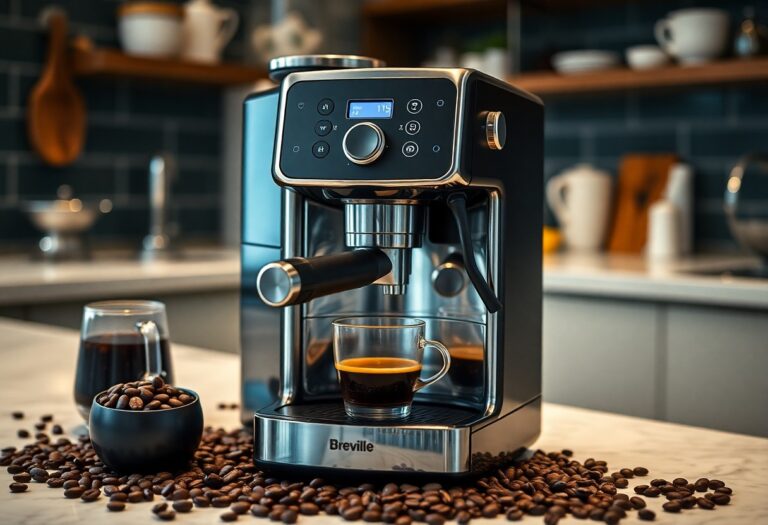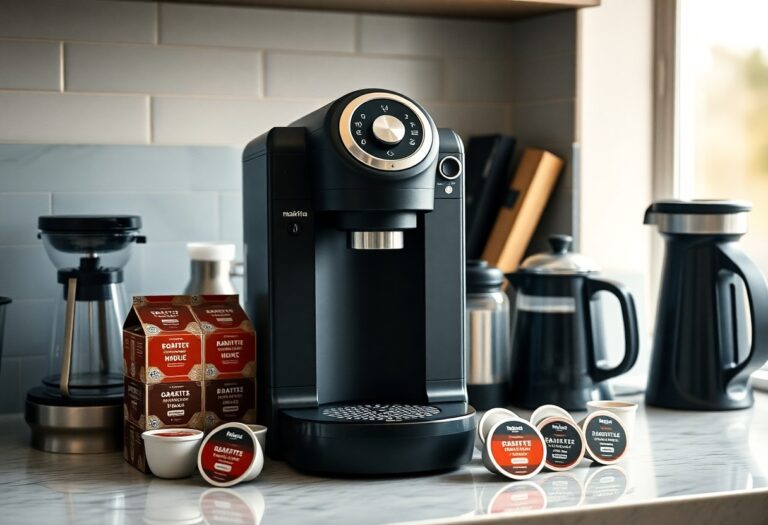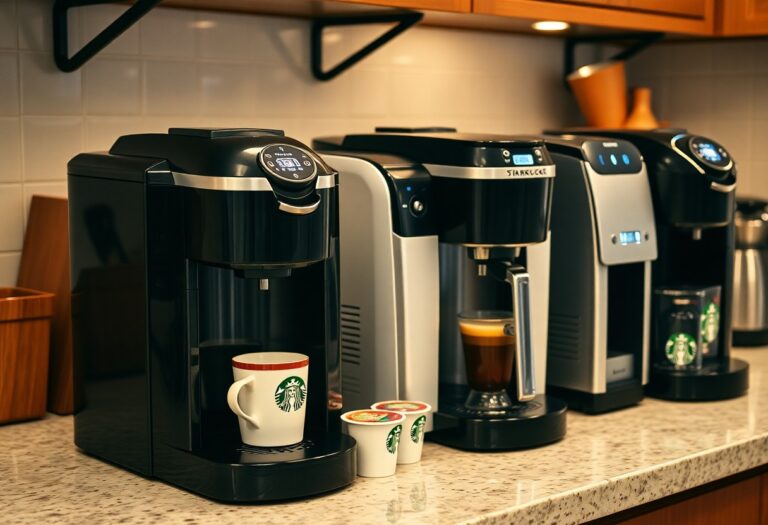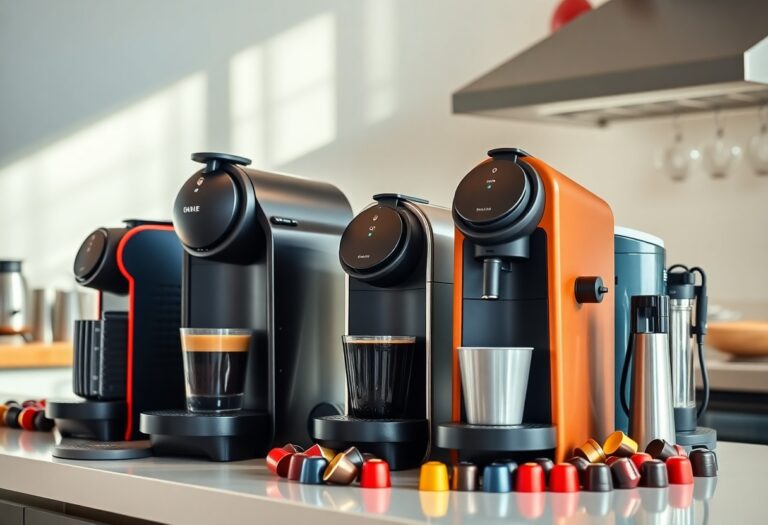What Coffee Grind for a Coffee Machine – Grind Size Guide
Over time, the right grind size can transform your coffee experience from ordinary to extraordinary. You’ll discover that each coffee machine requires a specific grind to extract optimal flavors and aromas from your beans. From coarse for French presses to fine for espresso machines, using the wrong grind can lead to a subpar brew or even an unpalatable cup. In this guide, we’ll break down the ideal grind sizes tailored for your coffee machine, ensuring you enjoy every sip. Get ready to elevate your coffee game!

Key Takeaways:
- Coarse grind is ideal for French press and cold brew methods, allowing for a longer extraction time without over-extraction.
- Medium grind is suitable for drip coffee machines, providing a balanced extraction time for optimal flavor.
- Fine grind works best for espresso machines, as it allows for quick extraction under pressure, resulting in rich and concentrated coffee.
- Adjust grind size based on brewing time; shorter brew methods typically require finer grinds, while longer methods can use coarser grinds.
- Experiment with grind sizes to find the perfect match for your specific machine and personal taste preferences.

The Perfect Brew: Decoding Grind Sizes for Every Coffee Machine
The grind size of your coffee can profoundly affect the overall flavor and quality of your brew. Each coffee machine has its specific requirements for grind consistency to ensure optimal extraction. By understanding the various grind sizes and their respective uses, you can easily tailor your coffee experience to suit your taste preferences and equipment.
Espresso Machines: Fine Grind Elegance
For espresso machines, a fine grind is necessary to create that rich and concentrated shot of espresso. This ultra-fine texture allows hot water to pass through the coffee grounds quickly, extracting maximum flavor and oils in a short amount of time.
Drip Coffee Makers: Medium Grind Balance
A medium grind strikes the ideal balance for drip coffee makers, offering a uniform extraction process that produces a clean and flavorful cup. This consistency is vital since the water’s contact time is longer than in an espresso machine, necessitating a coarser texture than fine grinds yet finer than what you’d use for a French press.
Choosing a medium grind allows for a smoother flow of water through the coffee bed, preventing over-extraction that can make your coffee taste bitter. A good starting point is to aim for a granule size similar to table salt, enabling a harmonious combination of flavors and aromas without overwhelming bitterness or acidity.
French Press: Coarse Grind Richness
A coarse grind is highly recommended for French press coffee brewing. It enhances extraction while minimizing sediment, which is necessary for achieving that idyllic full-bodied flavor characteristic of this brewing method.
The coarse grind size resembles chunks of sea salt, allowing the coffee to steep without becoming bitter while also permitting easy separation from the brewed liquid. This grind size invites a richer, smoother flavor, accentuating the aromatic oils and robust characteristics of your coffee beans. The longer steep time, typically around four minutes, complements the coarser texture, resulting in a delightful cup that highlights the coffee’s natural sweetness and depth.
The Impact of Grind Size on Flavor Profile
Your choice of grind size significantly shapes the flavor profile of your coffee. Different grind sizes release distinct compounds during brewing, influencing acidity, sweetness, and bitterness. For a deeper understanding of how to achieve the perfect flavor balance, refer to The Essential Guide to Coffee Grind Sizes. Larger particles will result in a smoother, milder flavor, while finer grounds can enhance bitterness and intensify aromatic qualities. This relationship between grind and flavor is important for both casual drinkers and dedicated coffee enthusiasts alike.
Extraction Dynamics: How Grind Size Alters Taste
The size of your coffee grind directly influences the extraction dynamics during brewing. Finer grinds expose more surface area to water, leading to rapid extraction of oils and flavors, which can enhance bitterness if over-extracted. Conversely, coarser grinds extract flavors more slowly, often resulting in milder brews. This means that your grind size can entirely change your coffee experience, transforming a simple cup into a complex tasting journey.
The Science of Brewing Time and Grind Size
The brewing time must align with your grind size for optimal extraction. For instance, a pour-over method typically requires a medium grind and a brewing time of 3 to 4 minutes. In contrast, espresso necessitates a fine grind and a shorter extraction time, around 25-30 seconds. Recognizing how these elements interact is fundamental in achieving the desired balance of flavors in your coffee.
Understanding the science behind brewing time and grind size enables you to tailor your coffee to your taste preferences. If you prefer a more robust and complex cup, experimenting with finer grinds combined with shorter brewing times can yield rich results. Alternatively, for a lighter and brighter flavor, a coarser grind with a longer brewing period will work well. Adjusting these variables can enhance your overall coffee experience, leading you to discover personalized taste profiles that resonate with your palate.
Tailoring Your Grind for Different Beans
Adapting your coffee grind to suit specific beans enhances the overall flavor and aroma, allowing you to appreciate the unique characteristics of each type. Whether you’re working with Arabica, Robusta, or a blend, understanding the nuances in grind size can elevate your coffee experience. Fine-tuning your grind according to the properties of the beans you choose will bring out their best qualities, ensuring every cup is as delicious as possible.
Arabica vs. Robusta: Variances in Grind Needs
Arabica and Robusta beans have distinct flavor profiles, leading to differences in their grind requirements. Arabica beans, known for their sweetness and complex acidity, typically benefit from a medium to medium-fine grind. In contrast, Robusta, which has a bolder, earthier taste, often works well with a coarser grind, thereby preserving its heavier body while avoiding bitterness during brewing.
Single-Origin vs. Blends: Finding Your Ideal Consistency
When working with single-origin coffee, aim for a grind size that highlights the specific flavors and aromas of that bean, which can often require fine-tuning based on the region of origin. In contrast, blends tend to call for a more uniform grind to ensure a balanced flavor profile, allowing the various beans to meld together harmoniously.
The grind size for single-origin coffees can vary widely depending on the specific characteristics of the bean. For instance, an Ethiopian Yirgacheffe with bright floral notes may shine with a finer grind, whereas a bold, chocolatey Colombian might call for a slightly coarser consistency. Single-origin beans reflect their terroir, and a tailored grind allows you to extract the unique essence of each coffee, enhancing the tasting experience. On the other hand, blends require a grind that achieves a harmonious balance among the different beans used, resulting in a consistent cup that showcases the blended flavors without overshadowing any single component.
Common Grinding Mistakes to Avoid
Achieving the perfect brew isn’t solely about selecting quality beans; grind size mistakes can lead to disappointing results. Two common pitfalls in the grinding process include over-grinding and under-grinding, each affecting the flavor and overall experience of your coffee. Awareness of these mistakes can help you refine your technique and unlock the full potential of your brew.
Over-Grinding: The Bitter Trap
Grinding your coffee beans too finely can mask the nuanced flavors with unwanted bitterness. This phenomenon occurs due to over-extraction, where excessive surface area leads to an imbalanced extraction process. A fine grind often suits espresso, yet going too far will leave your coffee harsh and unpleasant. Proper grind monitoring prevents this bitter trap.
Under-Grinding: Missing the Flavor Mark
Using a grind that’s too coarse results in under-extraction, causing your brew to lack the desired richness and complexity. This often leads to a watery taste, where necessary oils and flavors remain trapped within the beans. Achieving the right balance is key; aim for a grind that complements your brewing method to fully extract the coffee’s potential.
Under-grinding severely limits flavor extraction, failing to unlock the beans’ oils and sugars that contribute to a rich, aromatic cup. For instance, coarse grind works well for French press but can yield a weak brew if mismanaged. The goal is to achieve a medium or fine grind that suits your method—each brewing technique like pour-over or Aeropress has unique requirements. Experimenting with grind size will sharpen your skills and elevate your morning ritual.
Essential Tools for Achieving the Perfect Grind
To master the art of grinding coffee, selecting the right tools is crucial. The right grinder can make a world of difference in your coffee experience. Investing in a high-quality grinder ensures you achieve consistent grind sizes tailored to your brewing method, unlocking the full potential of your coffee beans. Understanding the two main types of grinders, burr and blade, will help you make an informed decision on what’s best for your brewing needs.
Burr Grinders vs. Blade Grinders: A Comparison
| Burr Grinders | Blade Grinders |
|---|---|
| Provide a consistent grind size. | Can produce uneven grind size. |
| Offers adjustable grind settings. | Limited control over grind size. |
| Usually more expensive but worth the investment. | More affordable, but can compromise on quality. |
| Preserves flavor and aroma better. | Can heat beans, potentially affecting flavor. |
Manual vs. Electric: Choosing Your Grinding Method
Selecting between a manual or electric grinder largely depends on your personal preferences and coffee habits. Manual grinders offer greater control and can be more affordable, making them a great option for those who appreciate the tactile experience of grinding beans. On the other hand, electric grinders provide convenience and speed, which can be especially beneficial for daily use or when preparing coffee for multiple people. Consider how often you’ll be grinding, the level of control you desire, and your budget when making this decision.
Manual grinders typically require a bit more effort and time, which can be seen as a meditative practice for coffee enthusiasts. They often deliver finer control over grind size, allowing you to customize the coarseness to match your brew method perfectly. Electric grinders, however, cater to those who value convenience, allowing for quick grinding with minimal effort. If coffee is a significant part of your daily routine and time is of the essence, you might lean towards an electric grinder for its efficiency. Ultimately, the best choice aligns with your lifestyle and taste preferences.
Summing up
Hence, choosing the right coffee grind size for your coffee machine can elevate your brewing experience, enhancing flavor extraction and ensuring optimal taste. By tailoring the grind to your specific brewing method—whether it’s coarse for French presses or fine for espresso—you can achieve the best results. To assist you in this process, refer to the Coffee Grind Chart – The Best Coffee Guide for detailed recommendations that will guide your grinding choices.
FAQ
Q: What is the best grind size for a drip coffee machine?
A: For a drip coffee machine, a medium grind size is ideal. This texture resembles regular granulated sugar and allows for a balanced extraction during the brewing process. If the grind is too coarse, the water will pass through too quickly, resulting in weak coffee. Conversely, if it’s too fine, it may lead to over-extraction and a bitter taste.
Q: How fine should the coffee grind be for an espresso machine?
A: Espresso machines require a fine grind size comparable to table salt. This is necessary because espresso brewing works under high pressure and short extraction times, meaning the coffee needs to be packed tightly to allow water to extract flavors efficiently. A grind that is too coarse will produce under-extracted shots that lack the rich and bold profile typical of espresso.
Q: What grind size is recommended for a French press?
A: A coarse grind size is recommended for a French press. The texture should be similar to sea salt or breadcrumbs. Since the brewing process involves steeping the coffee grounds in hot water for several minutes, a coarse grind helps prevent over-extraction and results in smoother, less bitter coffee. Additionally, a coarser grind makes it easier to separate the grounds from the brewed coffee when pressing the plunger.
Q: How do I determine the right grind size for a pour-over coffee maker?
A: For pour-over coffee makers, a medium to medium-fine grind size is typically best. This allows for optimal extraction, as the hot water flows through the coffee grounds at a controlled rate. A grind that is too coarse may lead to under-extraction, producing a weak brew, while a grind that is too fine can cause over-extraction, leading to bitterness. Experimenting within this range can help you find the perfect balance for your specific setup.
Q: Can the grind size affect the flavor of my coffee?
A: Yes, the grind size significantly impacts the flavor profile of your coffee. Different brewing methods require different grind sizes to optimize extraction and flavor. A grind that is too fine or too coarse can result in imbalanced flavors, whether it be overly bitter or weak. Adjusting your grind size according to your brewing method can enhance overall taste and achieve the desired strength and aroma in your cup.







